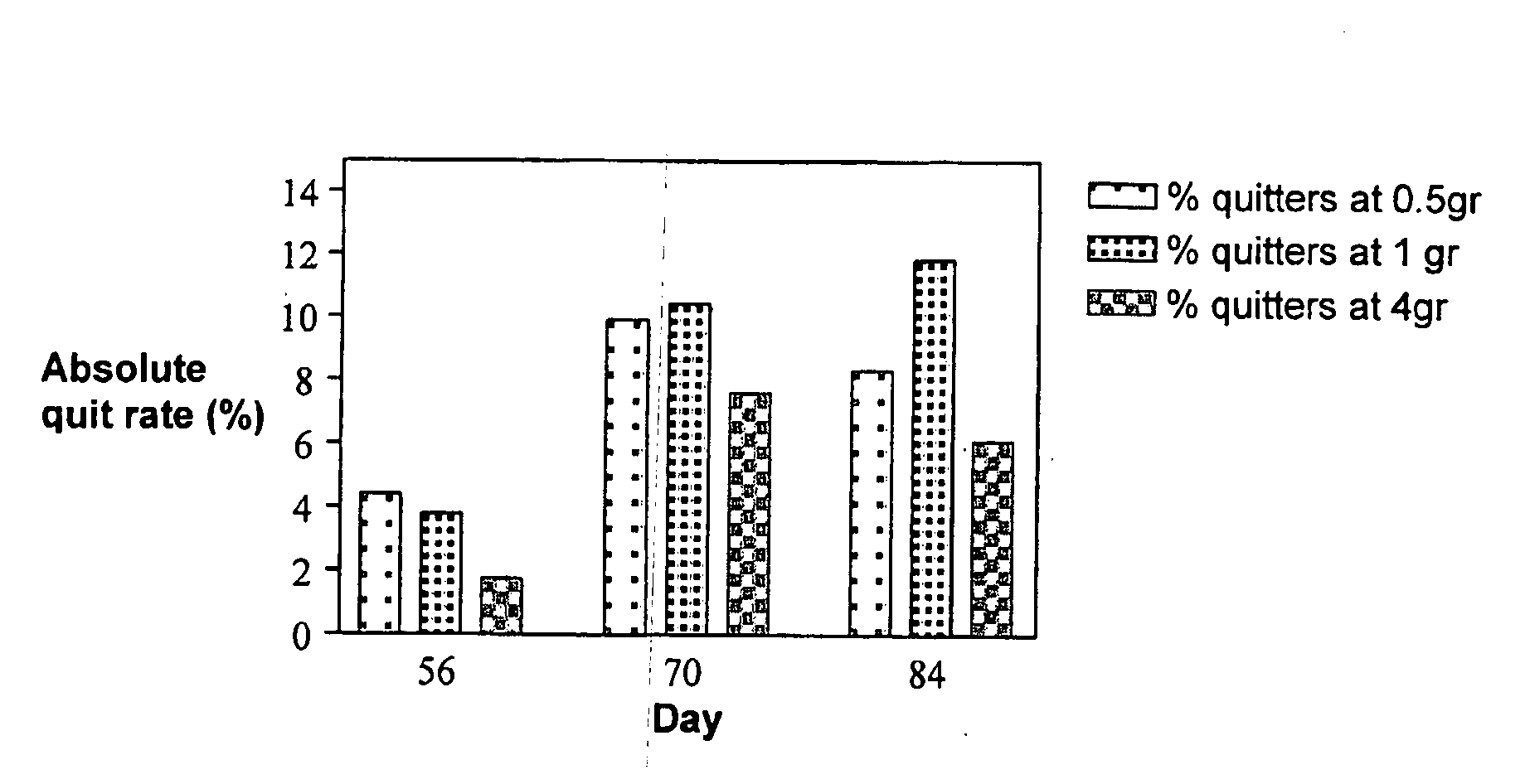Compositions and methods for smoking cessation
a smoking cessation and composition technology, applied in the field of compositions and methods for smoking cessation, can solve the problems of 29% biochemically verified abstinence, rapid development of severe withdrawal symptoms, and difficult smoking cessation, and achieve the effect of minimizing disruptive interaction, reducing the effect of smoking cessation, and prolonging the cessation period
- Summary
- Abstract
- Description
- Claims
- Application Information
AI Technical Summary
Benefits of technology
Problems solved by technology
Method used
Image
Examples
example 1
PA Composition
[0052]Capsules made of gelatin (Type LB, Gel Formula 3A), size 22, oblong, brown colored (151A) were used. Each capsule contained: PA mixture, oil and vitamin E to a total weight of 1000 mg. The total PA in such a composition was between 15-25% w / w.
[0053]Formulation 1 contained 7% PA: 400 mg canola oil, about 50-80 mg phosphatidic acid, Vitamin E and about 440 mg of other phospholipids.
[0054]Formulation 2 contained 16% PA: 400 mg canola oil, about 160 mg phosphatidic acid, 3.5 mg Vitamin E, and about 436 mg other phospholipids.
[0055]Formulation 3 contained 18% PA: 400-500 mg canola oil or peanut oil, about 180 mg phosphatidic acid, 3.5 mg Vitamin E, and about 300-407 mg other phospholipids.
[0056]Formulation 4 contained 22% PA: 400-500 mg canola oil, about 200-220 mg phosphatidic acid, 3.5 mg Vitamin E, and about 300-400 mg other phospholipids.
[0057]Formulation 5 contained equal weight amounts of PA and PS (ratio of 1:1): such a formulation is prepared by mixing PA and ...
example 2
In Vivo Studies
[0064]Study 1: Forty one smokers of more than 10 cigarettes per day (CPD), healthy men or (non-pregnant) women, who admitted to smoking for at least 1 year and who were unable to stop smoking, completed a double-blind, placebo controlled study (placebo containing triglyceride only), in which a single dose, given twice daily of a composition containing varying amounts of 15-25% phosphatidic acid (PA) in triglyceride, was administered orally in a liquid preparation over a period of 3 weeks, starting two days prior to smoking cessation.
[0065]In one test group, there were 19 males and 22 females, 20 in the active treatment group and 21 in the placebo group. Nicotine dependency and withdrawal symptoms were assessed by questionnaires adapted from the Fagerstrom Tolerance Questionnaire (FTQ). A final score ranging from 1-5 was applied for statistical evaluation. A reduction in the craving for food (p<0.05) after 1 week and a significant decrease in the craving for cigarettes...
example 3
Weight Gain and Smoking Cessation
[0077]Weight gain is one of the most feared from side effect associated with smoking cessation. As will be shown hereinbelow, treatment with the compositions of the present invention leads to a much smaller weight gain for subjects who stopped smoking as compared with the placebo treated subjects.
[0078]Weight gain was measured for subjects who reached the end of the study (so called “per protocol”) and was calculated as weight at day 70 (the last weighing procedure) minus weight at day 7 (the first weighing procedure). As shown in Table 4, among the “treated” versus “placebo” groups, the subjects who stopped smoking while receiving placebo gained 3.42 kg while the subjects treated with compositions comprising 0.5 grams or 1.0 grams PA gained on average 1.52 kg (P=0.006).
[0079]Another surprising observation is the effect of heavy smokers versus light smokers. As may be noticed from Table 4, if “treated” versus “placebo” is compared for both heavy smok...
PUM
| Property | Measurement | Unit |
|---|---|---|
| w/w | aaaaa | aaaaa |
| weight | aaaaa | aaaaa |
| composition | aaaaa | aaaaa |
Abstract
Description
Claims
Application Information
 Login to View More
Login to View More - R&D
- Intellectual Property
- Life Sciences
- Materials
- Tech Scout
- Unparalleled Data Quality
- Higher Quality Content
- 60% Fewer Hallucinations
Browse by: Latest US Patents, China's latest patents, Technical Efficacy Thesaurus, Application Domain, Technology Topic, Popular Technical Reports.
© 2025 PatSnap. All rights reserved.Legal|Privacy policy|Modern Slavery Act Transparency Statement|Sitemap|About US| Contact US: help@patsnap.com


